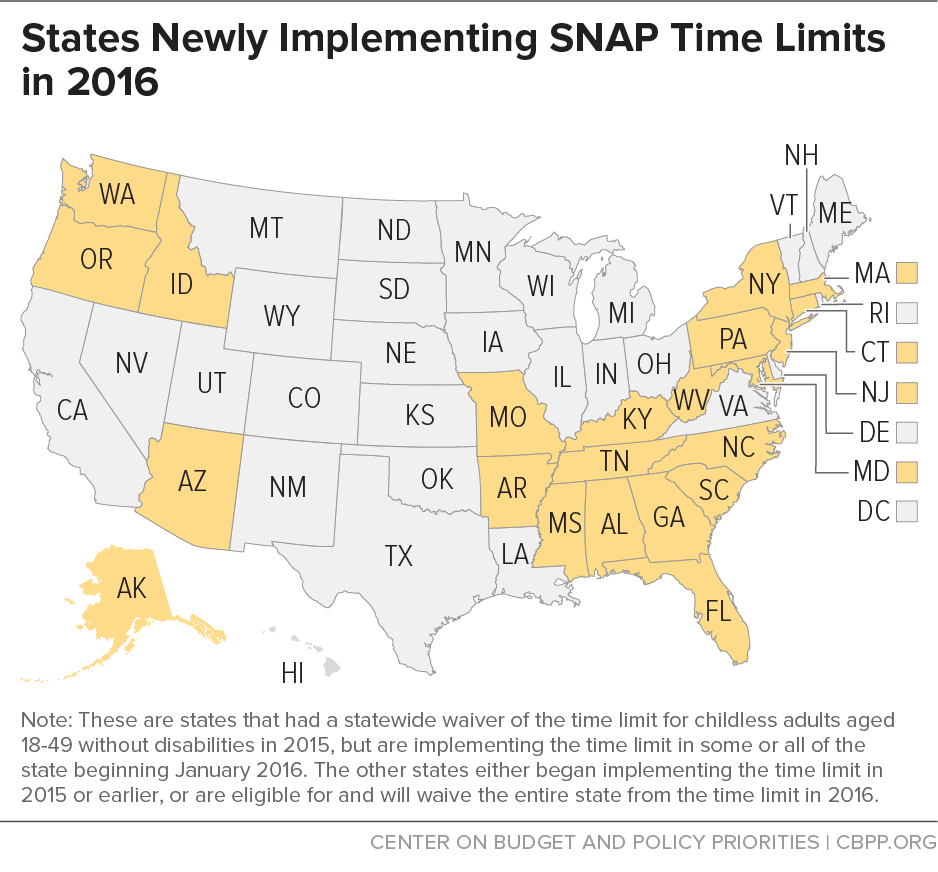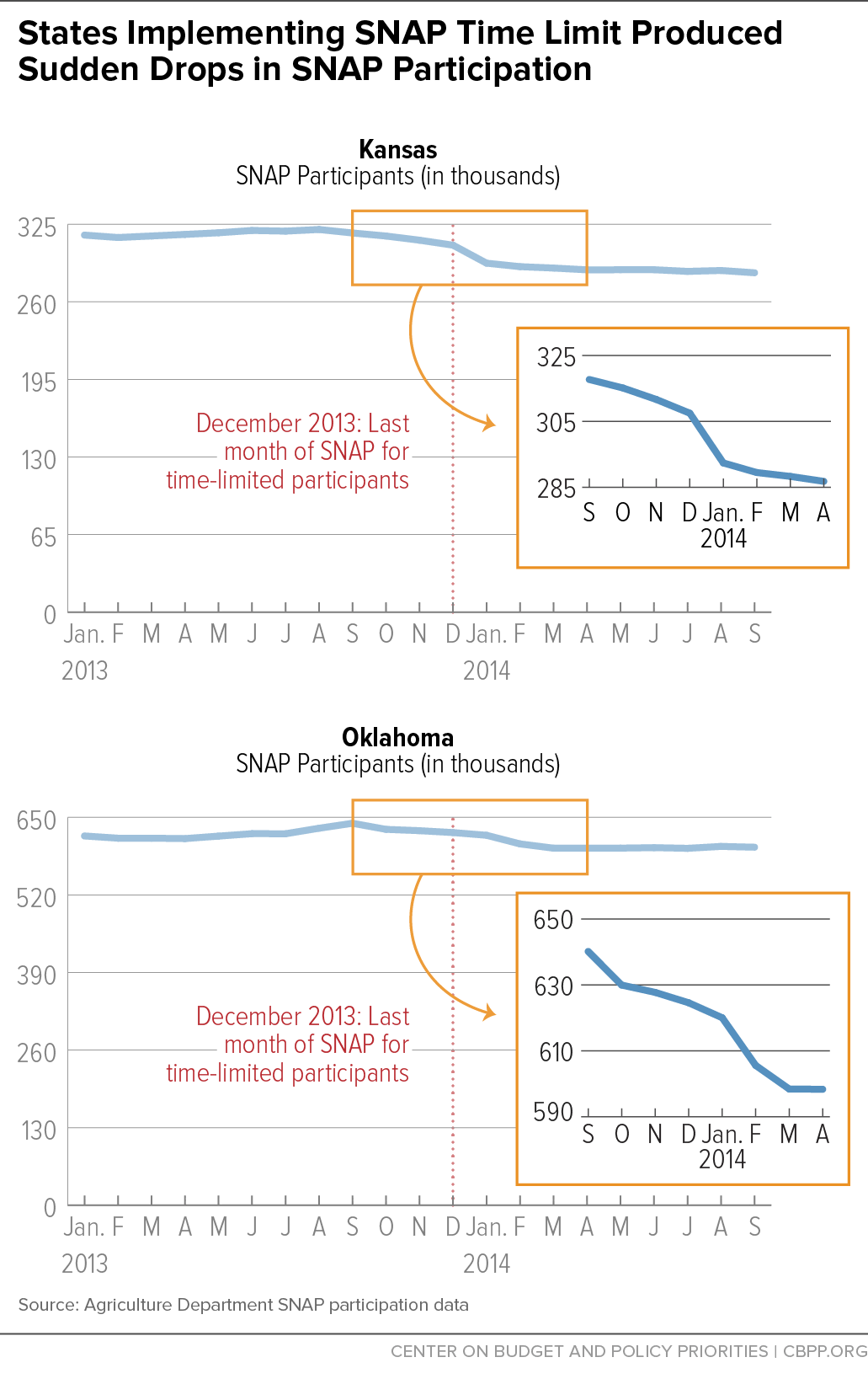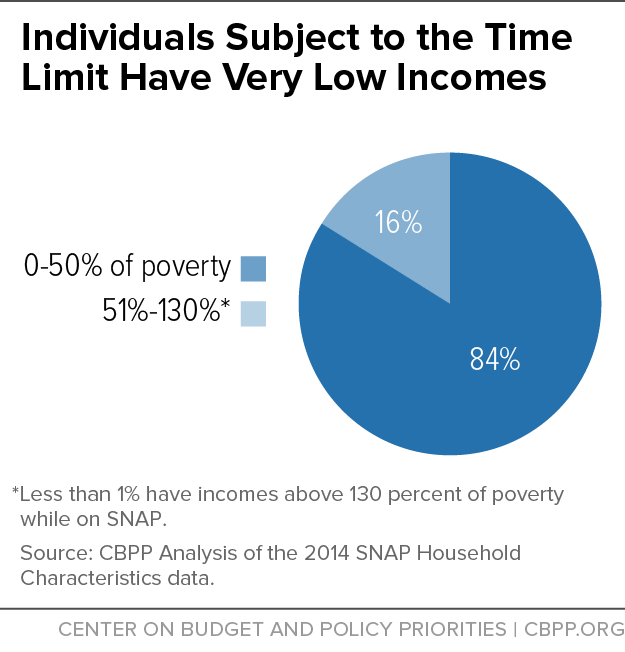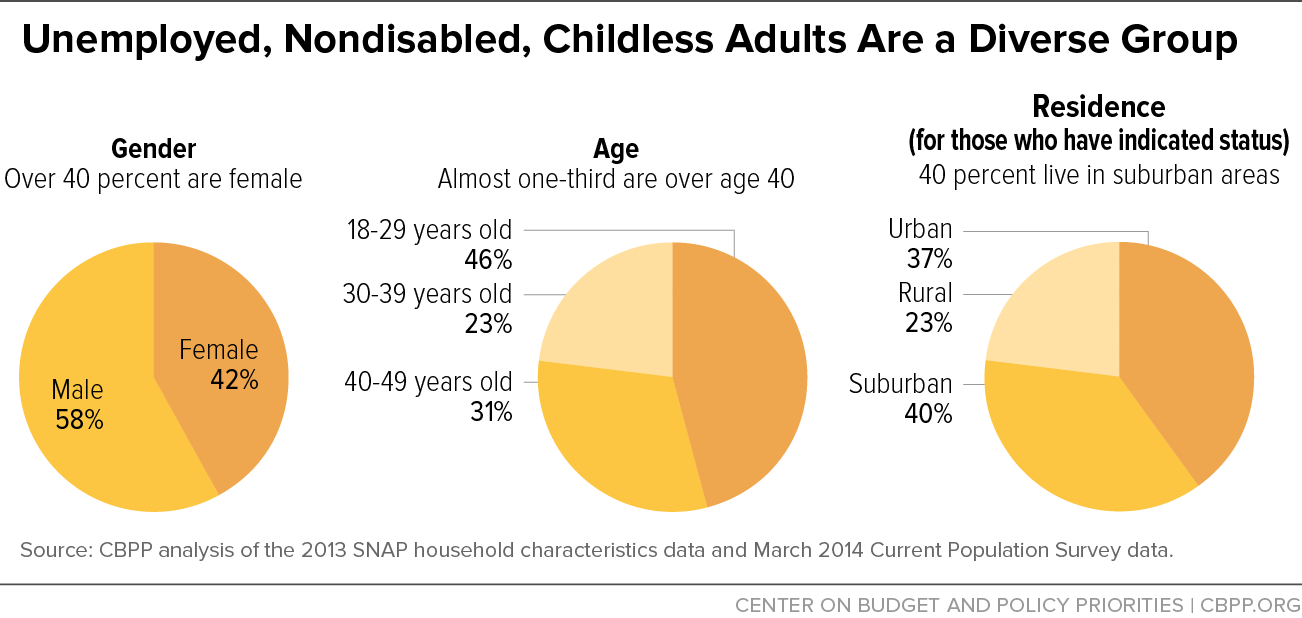More than 500,000 and as many as 1 million of the nation’s poorest people will be cut off SNAP (formerly known as the Food Stamp Program) over the course of 2016, due to the return in many areas of a three-month limit on SNAP benefits for unemployed adults aged 18-49 who aren’t disabled or raising minor children. These individuals will lose their food assistance benefits after three months regardless of how hard they are looking for work. The impact will be felt in the 22 states that must or are choosing to reimpose the time limit in 2016.
One of the harshest pieces of the 1996 welfare law, this provision limits such individuals to three months of SNAP benefits in any 36-month period when they aren’t employed or in a work or training program for at least 20 hours a week. Even SNAP recipients whose state operates few or no employment programs and fails to offer them a spot in a work or training program — which is the case in most states — have their benefits cut off after three months irrespective of whether they are searching diligently for a job. Because this provision denies basic food assistance to people who want to work and will accept any job or work program slot offered, it is effectively a severe time limit rather than a work requirement, as such requirements are commonly understood. Work requirements in public assistance programs typically require people to look or work and accept any job or employment program slot that is offered but do not cut off people who are willing to work and looking for a job simply because they can’t find one. In fact, SNAP has separate work requirement authority much like this, where states can require individuals to participate in job search or a training program but cannot terminate them if no program is available.
In the past few years, the three-month limit hasn’t been in effect in most states. The 1996 welfare law allows states to suspend the three-month limit in areas with high and sustained unemployment; many states qualified to waive the time limit throughout the state due to high unemployment rates during and since the Great Recession. But as unemployment rates fall, fewer areas are qualifying for statewide waivers. Most states have counties and other localities that are eligible for waivers because they continue to have especially high unemployment.
In 2016, the time limit will be in effect in more than 40 states. In 22 states, it will be the first time the time limit has been in effect since before the recession. (See Figure 1.) Of these states, 19 must reimpose the time limit in at least part of the state; another three are electing to reimpose the time limit despite qualifying for a statewide waiver from the time limit because of continued high unemployment.[1]
As a result, at least 500,000 and as many as 1 million SNAP recipients will have their benefits cut off in 2016. A few southeastern states that are electing to re-implement the time limit statewide even though some or all of the state qualifies for a waiver, such as Arkansas, Florida, Mississippi, and North Carolina will be particularly hard hit. In most of these states the time limit took effect in January 2016 and the first people will be cut off three months later, in April. (We developed the estimate based on historical SNAP administrative data and Agriculture Department [USDA] data on states’ approved 2016 waivers.[2])
The loss of this food assistance, which averages approximately $150 to $170 per person per month for this group, will cause serious hardship among many. USDA data show that the individuals likely to be cut off by the three-month limit have average monthly income of approximately 17 percent of the poverty line, and they typically qualify for no other income support.
The indigent individuals at risk are diverse.[3] More than 40 percent are women. Close to one-third are over age 40. Among those who report their race, about half are white, a third are African American, and a tenth are Hispanic. Half have only a high school diploma or GED, and one-quarter have not completed high school. They live in all areas of the country, and among those for whom data on metropolitan status are available, close to 40 percent live in urban areas, 40 percent in suburban areas, and over 20 percent in rural areas.[4]
Many in this population, which generally has limited education and skills and limited job prospects, struggle to find employment even in normal economic times. And although the overall unemployment rate is slowly falling, other labor market data indicate that many people who want to work still cannot find jobs, while others who want to work full-time can find only part-time employment. Cutting off food assistance to poor unemployed and underemployed workers doesn’t enable them to find employment or secure more hours of work.
Congress could revise this harsh rule to better accomplish its stated goal of testing individuals’ willingness to work. For example, Congress could make the three-month limit in a given state contingent on the state offering a job or training position to all nondisabled childless adults subject to the limit who don’t otherwise find employment. Congress could also allow diligent job search to count toward the requirement, as it generally does under work requirements for other programs.
But such congressional action seems unlikely. Consequently, states and local charities that work with this population need to prepare for the return of the three-month cut-off provision on a large scale. States need to be prepared to reinstate this complex rule properly and to engage stakeholders and prepare them for the consequences as substantial numbers of indigent individuals in their communities lose food assistance.
Under the 1996 welfare law, adults aged 18-49 who are not physically or mentally unfit for work or caring for a minor child are ineligible for SNAP if they have received three months of SNAP benefits while unemployed during the previous 36 months.[5] Months of SNAP receipt don’t count toward the limit if the individual is working at least half-time, participating in qualifying work or training program activities for at least 20 hours a week, doing workfare, or living in an area with high unemployment where the three-month limit is temporarily waived. When signing the welfare law in 1996, President Clinton singled out this as one of the bill’s most harmful provisions and called for it to be substantially changed.[6]
Since states don’t provide half-time employment opportunities to SNAP recipients, the only way that an unemployed person can maintain SNAP eligibility during normal economic times (i.e., when a high-unemployment waiver is unavailable) is to find 20 hours a week of job training or another work program, or find a workfare slot.[7] Job search, the lowest-cost activity for a state to require and monitor, does not count as an allowable activity.[8]
Yet states aren’t required to offer these recipients a place in a work or training program for 20 hours a week, and very few states do. This leaves it up to individuals who can’t find a job to try to find training or work program openings on their own, which few are able to do, especially since most training programs have insufficient resources to meet demand, resulting in substantial waiting lists. A person who wants to work but is unable to find a job, and is willing to participate in job training but has no opportunity to do so, loses all of his or her SNAP benefits at the three-month point.
The welfare law allows states to request a temporary waiver of the three-month limit in areas with persistently high unemployment, an option that was critical to Congress’ approval of the three-month cut-off. Then-representatives John Kasich (R-OH) and Rob Ney (R-OH), the three-month limit’s authors in 1996, said on the House floor that the provision wouldn’t have draconian effects for two reasons: 1) states would offer workfare programs to all people who couldn’t find a job; and 2) states could seek waivers to suspend the three-month cut-off in localities with high unemployment or insufficient jobs. They presented the provision as one that would push people to look for work, provide them with a workfare slot if they couldn’t find a job, and allow states to waive the requirement if there were insufficient jobs.[9]
But despite the authors’ claims, the provision neither required states to offer workfare programs or job training to people who were unable to find a job nor provided funds to states for that purpose. Most states do not offer these programs, in part because operating a work program with enough slots for everyone at risk of hitting the three-month time limit is too expensive.
Each year, only about five states use additional federal funding available to provide a job training or workfare slot to every nondisabled childless adult at risk of losing SNAP benefits after three months. (Colorado, Delaware, South Dakota, Texas, and Wisconsin have pledged to offer a qualifying work slot in 2016 to every nondisabled childless adult subject to the three-month limit.[10]) States that offer a training slot to all individuals facing the time limit can receive a pro-rata share of $20 million in federal funding to defray the cost. (The $20 million annual fund was established in 1997 in response to criticism of the 1996 law.) States can commit to serve these individuals without accessing the special federal funding, though this is unusual. For example New York requires that counties where the time limit is in effect provide a slot when requested by an individual subject to the time limit.
Each state also receives its share of the regular $79 million in federal funding provided to states each year for SNAP employment and training programs. Most states, however, have used the majority of the federal funds for programs and work-related services for other SNAP recipients, such as those with children.[11] Moreover, these resources generally fall far short of the cost of providing work or training programs to all jobless individuals in a state who face the three-month cut-off, even if the state wanted to do so.
In contrast, the temporary waiver option for areas with high unemployment has provided significant protection in the past few years for people facing the three-month limit. During the Great Recession, nearly every state suspended the time limit due to soaring unemployment.[12] In stronger economic times, a smaller number of states with regions or counties with persistently high unemployment have received waivers for those areas.
Use of these high-unemployment waivers hasn’t had a political dimension; every state except Delaware has used its waiver authority at some point over the last 19 years to temporarily suspend the three-month limit in at least part of the state so that poor jobless workers in high-unemployment areas would have access to food while looking for work. Governors of both parties have used this flexibility in high-unemployment areas of their states.
Many of the states with waivers from the three-month limit impose regular SNAP work requirements on childless unemployed adults, and individuals who don’t comply with the work requirements, such as looking for work or participating in a training program, are subject to having their benefits cut off. But they are not terminated from SNAP simply for being unemployed, as long as they comply with their state’s work requirements.
In 2016, the three-month time limit will be in effect in areas with about 65 percent of the U.S. population; the rest of the country has sufficiently high and persistent unemployment to continue qualifying for waivers and states have sought them.[13] By contrast, in 2015, the time limit was only in effect in areas with about 30 percent of the country’s population.
As waivers disappear across the country, some nondisabled childless adults subject to the three-month limit will be able to meet the requirements necessary to maintain SNAP eligibility, such as finding at least half-time work, participating in job training for at least 20 hours a week, or qualifying for an exemption. But we estimate that many — at least 500,000 and as many as 1 million poor individuals — will lose SNAP benefits as a result of states’ re-imposition of the three-month time limit.
The recent history of states that have reimposed the three-month limit is illustrative. In fiscal year 2014, Kansas and Oklahoma reimposed the time limit after several years of statewide waivers. Beginning three months after the time limit took effect, these states’ caseloads dropped significantly. While caseloads had been slowly declining (as is typical when unemployment falls) even before reimposition of the time limit, the drop accelerated substantially three months after the time limit returned.[14] These states did not offer workfare or job training slots to all nondisabled childless adults at risk of losing benefits. As a result, the provision was implemented as a time limit rather than a work requirement.
For example, Kansas reimposed the time limit in October 2013, with the first childless adults losing eligibility three months later, in January 2014. The caseload decline expected due to the improving economy — about 3,000 to 4,000 participants per month — suddenly accelerated in January to about 15,000 individuals, then returned to its previous pace (see Figure 2).
A significant share of the about 5,000 nondisabled childless adults in Franklin County, Ohio who became subject to the three-month cut-off since Ohio reimposed the time limit there in December 2013 faced multiple barriers to employment, according to a study conducted by the Ohio Association of Foodbanks. The findings highlight the issues that other states may face as their waivers expire.
- Demographics: Close to one-third of those subject to the three-month limit had never graduated from high school. Just over 10 percent were working for pay while subject to the time limit; another almost 10 percent were performing work in exchange for in-kind benefits such as housing.
- Barriers to employment: One-third of those subject to the three-month cut-off had a medical or physical limitation, including depression, post-traumatic stress disorder, or mental or learning disabilities. Sixteen percent needed supportive services like language interpretation or transportation to obtain employment. In addition, 13 percent reported being caregivers for a parent, relative, or friend. Finally, more than one-third had felony convictions, another barrier to employment.
The Ohio Association of Foodbanks partnered with the county SNAP agency to help place individuals identified as subject to the time limit in qualifying work activities after screening them. For more information, see “Comprehensive Report on Able-Bodied Adults Without Dependents, Franklin County Ohio Work Experience Program,” http://admin.ohiofoodbanks.org/uploads/news/ABAWD_Report_2014-2015-v3.pdf.
Unemployed, nondisabled childless adults on SNAP tend to be very poor. USDA data show that while these individuals participate in SNAP their gross income averages 17 percent of the poverty line — about $2,000 per year for a household of one in 2015 — compared to gross income of 57.8 percent of the poverty line for the average SNAP household overall. Over 80 percent of the people subject to the three-month limit live in households with incomes below half of the poverty line (see Figure 3). Some 97 percent live in households below 100 percent of the poverty line.[15]
Over 40 percent of this vulnerable population are women. Close to one-third are over age 40. Among those who report their race, about half are white, a third are African American, and a tenth are Hispanic. Half have only a high school diploma or GED, and one-quarter have not completed high school. They live in all areas of the country; among those for whom data on metropolitan status are available, close to 40 percent live in urban areas, 40 percent in suburban areas, and over 20 percent in rural areas. (See Figure 4.)
Other kinds of assistance won’t replace the lost SNAP benefits. SNAP is the only benefit available to most unemployed workers without children. All but a few states have eliminated their state-run cash assistance programs for poor childless adults (except, in some states, for people with a disability).[16] Most unemployed workers on SNAP either don’t qualify for unemployment insurance or any other federal or state cash or food assistance benefit or are long-term unemployed workers who have exhausted their unemployment benefits.
There is little evidence that SNAP participation discourages nondisabled adults from working when jobs are available. These generally are low-income, low-skill workers with limited job prospects. SNAP participants subject to the three-month cut-off are more likely than other SNAP participants to lack basic job skills like reading, writing, and basic mathematics, the Government Accountability Office (GAO) has found.[17]
While the economy has improved and the national unemployment rate has fallen, the labor market is not back to full health, particularly for low-skilled, less-educated individuals such as those who face the three-month cut-off.
- The unemployment rate for people lacking a high school diploma or GED — who make up about a quarter of all non-disabled childless adults on SNAP — was 8.1 percent in an average month of 2015, compared to an unemployment rate of 4 percent for those with at least a high school degree or more education.[18] Unemployment rates for workers in many lower-skilled occupations, such as the service industries, are also substantially higher than the overall unemployment rate.
- The employment-to-population ratio — the share of the adult population with a job (which is considered one of the best measures of labor-market strength or weakness since, unlike the unemployment rate, it isn’t lowered artificially when long-term unemployed workers give up looking and drop out of the labor force) — plummeted during the Great Recession and is not fully back to where it would be in a fully healthy labor market.
- Long-term unemployment hit record highs in the recession and remains unusually high; in November 2015, more than a quarter (25.7 percent) of the nation’s 7.9 million unemployed workers had been looking for work for 27 weeks or longer. Workers who, at a given point in time, have been unemployed for more than six months are only half as likely as those unemployed for shorter periods to have found employment by one month later, a 2014 study found.[19]
- Many of the jobs being created in the recovery are low paying and part time — in some cases for less than 20 hours a week — so some people who manage to find jobs may qualify for, and need, SNAP, yet be subject to the three-month cut-off.
SNAP’s time limit is complex and presents substantial administrative challenges. SNAP participants risk having their benefits cut off after three months despite being exempt from the three-month limit — or being in compliance with it.
To determine whether a nondisabled childless adult is eligible for SNAP, a state must identify the individual as a nondisabled childless adult, determine whether an exemption applies, and (for those not found exempt) determine for each month whether the individual worked or participated in a work or job training program for the required number of hours. The information necessary to make this determination will not typically be found in the individual’s case records because states had no reason to explore exemptions from the time limit while the time limit was not in effect. Similarly, states typically track an individual’s earnings instead of their hours worked. As a result, states must communicate with those potentially subject to the time limit to try capture this additional information. In addition, the state must track the 36-month period for each individual in order to determine whether the three-month limit has been reached. This is the only provision in SNAP law that requires counting and tracking months in this way, and it necessitates special computer programming and staff training.
Over the last several years, many states, driven by the demands of the Affordable Care Act, have designed, built, and implemented new automated eligibility systems. This technological improvement occurred while the majority of states had statewide waivers from the three-month limit and thus no need to track individual months in order to apply the three-month limit. Some states may not yet have programmed their systems to operationalize the time-limit rules.
Our estimate that 500,000 to 1 million people will lose food assistance could be too low if states do not properly identify individuals who are not subject to the time limit. When the three-month limit again takes widespread effect, states are supposed to assess each childless adult to determine whether an exemption applies, in order to ensure that people who are unable to work continue to qualify for SNAP. If states fail to do so accurately, some individuals could lose food assistance inappropriately.
For example, states may not always provide adequate guidance for caseworkers to identify people with temporary disabling injuries or mental illness who are unable to work for a period of time and thus are supposed to be exempt. Many SNAP participants are unaware that temporary disabling injuries can qualify someone for an exemption.
The challenges involved in implementing the three-month limit require state administrative resources. There is risk that some under-resourced SNAP agencies may inadvertently allow some childless adults to fall through the cracks.
While states are not required to provide a training opportunity or connection to a job, some states use a portion of their SNAP employment and training (E&T) programs to provide activities that enable some individuals to continue to receive benefits. Only a limited number of work-related activities, however, count toward the 20-hour-per-week requirement. One activity that does not count is job search — states’ most common and least expensive type of SNAP E&T activity, which requires an individual to apply for a designated number of jobs within a specified time period.[20]
The three-month limit for childless nondisabled adults is one of the most severe eligibility restrictions in SNAP. One effective way policymakers could moderate hunger and hardship among low-income people is by altering the three-month rule so it truly functions as the work requirement its proponents often mistakenly portray it as being — that is, as a work requirement that tests an individual’s willingness to work by offering an appropriate job or a position in a work or training program or requiring job search. Such an approach requires a state to offer a job or training position or other work activity, or to require job search, for all nondisabled childless adults subject to the limit.[21] Those who fail to comply lose their benefits. Those who comply do not. Members of both the House and Senate have introduced legislation that would shift the SNAP time limit to a true work requirement.[22] Unfortunately, these bills are unlikely to be enacted in 2016.
Other potential changes could mitigate the rule’s harshness by being more realistic about this population’s employment prospects. For example, the time limit could be increased from three to six months, reflecting the fact that the typical duration of state unemployment benefits is six months. This would give unemployed individuals a more realistic amount of time to find 20 hours a week or more of employment. In both 2002 and 2008, the Senate voted on a bipartisan basis to extend the limit to six months.[23]
Still another improvement would be to expand the kinds of allowable work activities, and in particular, to include job search. Modestly increasing the funding for SNAP E&T also could help states provide more work activities and opportunities for the indigent individuals subject to the time limit.
The return of the three-month limit on SNAP benefits for unemployed, nondisabled childless adults will have far-reaching impacts on low-income SNAP participants. The loss of benefits will likely increase hardship for at least 500,000 unemployed Americans who rely upon SNAP to meet their basic nutritional needs. With Congress unlikely to act, states need to begin planning for the reduction to ensure that clients and the many organizations and SNAP stakeholders that work with them are aware of the upcoming change and its effects.







